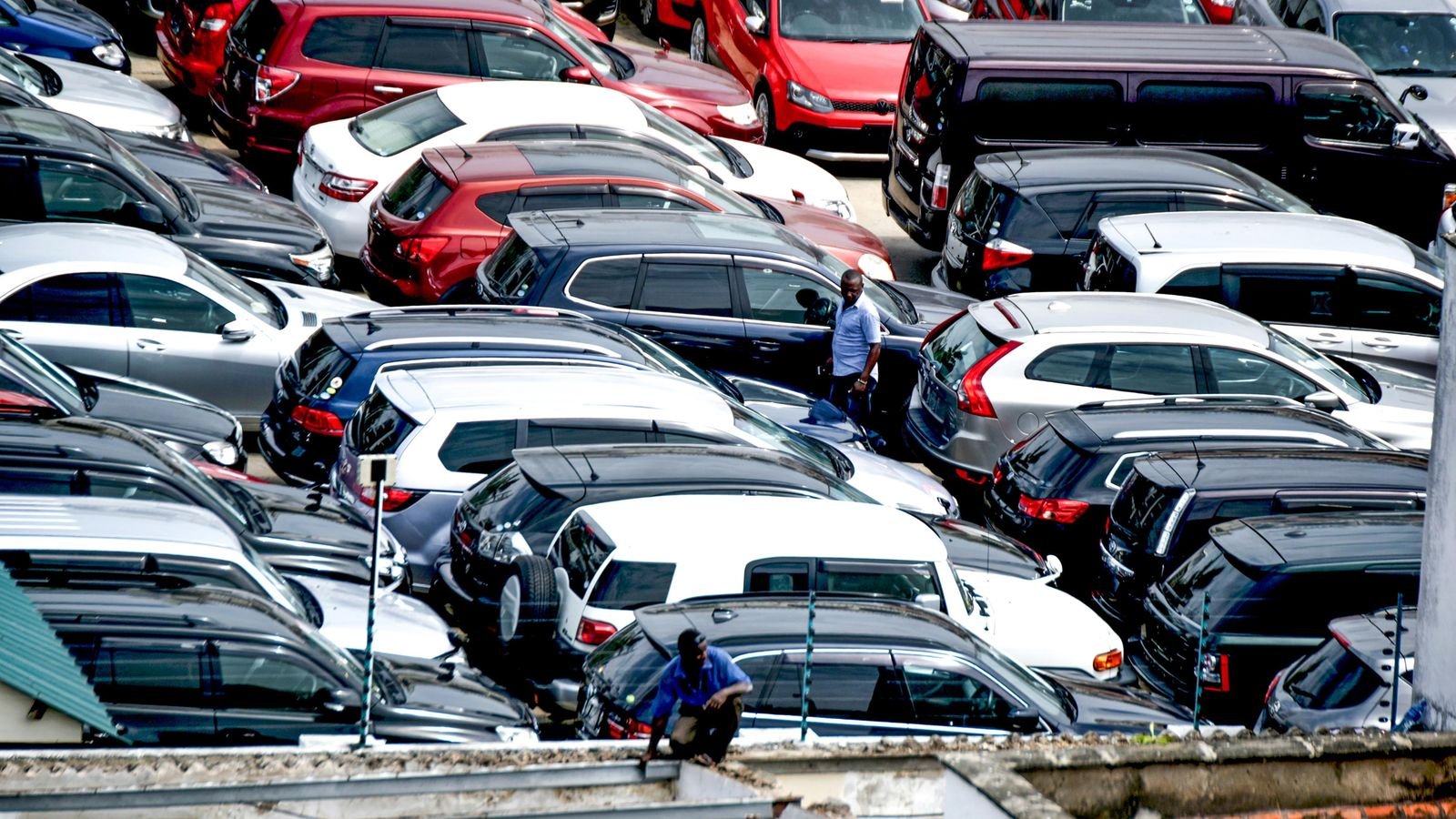Business
Probox to Cost Sh2.5M as KRA Announces New Import Tax Rules That Will Make Car Ownership Expensive
According to the new CRSP schedule, a Vitz Hybrid F will cost Ksh3,440,622, while a Prado TX-L-E4 will cost Ksh9,095,659, and a Mazda CX-5 20S will cost Ksh6,839,016. A Toyota Premio 2.0G will require Ksh4,344,220.

Kenya Revenue Authority’s revised taxation system effective July 1, 2025, signals dramatic price increases for popular vehicle models as second-hand car market braces for disruption
The dream of owning an affordable car in Kenya is set to become more elusive as the Kenya Revenue Authority (KRA) prepares to implement a new taxation framework that will significantly increase the cost of importing second-hand vehicles from July 1, 2025.
Under the new Current Retail Selling Price (CRSP) schedule, a Toyota Probox GL – one of Kenya’s most popular commercial vehicles – will now cost Ksh2,573,759, marking a substantial increase from current market prices.
This represents a seismic shift in Kenya’s automotive landscape, where the Probox has long served as an affordable workhorse for small businesses and taxi operators.
A Complete Overhaul of Car Import Taxation
The Kenya Revenue Authority announced that effective July 1, 2025, a new Current Retail Selling Price (CRSP) schedule will be applied in the computation of customs value for used motor vehicles imported into the country.
This change represents the most significant reform to Kenya’s car import taxation system in recent years.
The new system abandons the previous fixed-value CRSP model in favor of basing taxes on the actual price paid for the vehicle, as shown in invoices and receipts, with additional considerations for vehicle age, shipping costs, and import-related expenses.
Dramatic Price Increases Across Popular Models
The impact of the new taxation system extends far beyond the Probox.
According to the new CRSP schedule, a Vitz Hybrid F will cost Ksh3,440,622, while a Prado TX-L-E4 will cost Ksh9,095,659, and a Mazda CX-5 20S will cost Ksh6,839,016. A Toyota Premio 2.0G will require Ksh4,344,220.
These figures represent a fundamental shift in vehicle pricing that will affect Kenya’s entire automotive ecosystem, from individual buyers to commercial fleet operators.
The Mathematics Behind the Price Surge
The team received a draft of the updated CRSP listing, which revealed an average price increase of 40 percent compared to the 2019 list.
However, this increase is not uniform across all vehicle categories, with some models experiencing even steeper rises.
Multiple factors contribute to these dramatic increases:
Currency Devaluation Impact: In 2019, the exchange rate stood at approximately Ksh 100 to the dollar, while in 2025 the rate had risen to Ksh 130 to the dollar. This 30% currency depreciation directly translates to higher import costs.
Increased Duty Rates: The import duty rate increased from 25 percent in 2019 to 35 percent in 2025. The Excise Duty rate for some units is currently at 35% while in 2019 the highest Excise rate was at 30%.
Updated Valuation Methods: For vehicle units, particularly European makes, not listed in the Japanese Yearbook, Goo-net would serve as the alternative source for price references. Additionally, the meeting resolved to depreciate Japanese vehicle prices by 17 percent.
Industry Stakeholders Express Mixed Reactions
The announcement has generated significant concern within Kenya’s automotive sector.
Car dealers in Kenya are skeptical that the move to a new taxation model based on the invoice value of imported vehicles will significantly increase the car purchase price.
However, industry leadership presents a more nuanced view.
Car Importers Association of Kenya (CIAK) Chair Peter Otieno lauded the move saying the new system will tame dominance of clearing brokers taking advantage of unclear valuation.
Despite this endorsement, he called for training and smooth handling of the transition process from July 2025 to quell the disquiet among car dealers on its implications to their battered sector.
Digital Transformation and Compliance Requirements
The new system introduces significant technological requirements that will reshape how vehicle imports are processed.
The new system will see duty assessment set at the importer’s invoice value based on shipping documents submitted via the Integrated Customs Management System (iCMS).
This digital-first approach demands that importers upgrade their technological capabilities and ensure accurate documentation.
The change addresses complaints raised by car importers and clearing agents over apparent arbitrary valuations under the existing CRSP framework.
Government’s Revenue and Policy Objectives
From the government’s perspective, this reform serves multiple strategic objectives beyond revenue generation.
KRA Commissioner General Humphrey Wattanga says the changeover is aimed at fostering fairness, predictability, and efficiency while aligning its car duty systems with the global best practices in which the invoice value forms the basis of import taxation as opposed to arbitrary local valuations.
The timing of this reform coincides with Kenya’s broader fiscal consolidation efforts, as the government seeks to maximize revenue collection while improving tax compliance and reducing disputes.
Impact on Kenya’s Automotive Ecosystem
Commercial Vehicle Operators Face Uncertainty
The Probox’s new price point of Ksh2.57 million represents a particular challenge for Kenya’s vibrant matatu and taxi industry, where these vehicles serve as affordable commercial workhorses.
Small-scale entrepreneurs who have traditionally relied on the Probox’s affordability may find themselves priced out of vehicle ownership.
Middle-Class Car Ownership Under Pressure
The significant price increases across popular models like the Vitz, Premio, and CX-5 will directly impact middle-class Kenyans’ ability to purchase vehicles.
This could potentially slow Kenya’s motorization rate and affect related industries including insurance, maintenance, and financing.
Shift in Market Dynamics
Kenyan second-hand car dealers mainly source their units from Japan and UK and are charged higher import duty when their invoice price differs from KRA’s CRSP estimates.
The new system may force importers to reconsider their sourcing strategies and potentially explore alternative markets.
Preparing for the July Implementation
With the July 1 deadline approaching rapidly, stakeholders across the automotive value chain are scrambling to prepare for the changes. The successful implementation of this system will depend heavily on:
- Digital Infrastructure Readiness: The iCMS platform must handle increased documentation requirements without causing delays
- Stakeholder Training: Importers, clearing agents, and dealers need comprehensive training on the new procedures
- Documentation Compliance: Accurate invoicing and shipping documentation will become critical for smooth processing
Looking Ahead: Long-term Implications
The new CRSP system represents more than just a taxation change – it signals Kenya’s evolution toward more sophisticated, internationally aligned trade practices. While the immediate impact may be higher vehicle prices, the long-term benefits could include:
- Reduced valuation disputes between importers and KRA
- Greater transparency in the import process
- Improved revenue collection for government development programs
- Better alignment with World Trade Organization standards
However, the success of this transition will ultimately be measured by its ability to balance the government’s revenue objectives with the automotive sector’s viability and Kenyans’ continued access to affordable transportation.
As July 1 approaches, the automotive industry watches with bated breath to see how these sweeping changes will reshape Kenya’s car import landscape and whether the promise of greater fairness and transparency can offset the immediate pain of higher prices.
For millions of Kenyans aspiring to vehicle ownership, the era of the affordable Probox may be drawing to a close, marking the end of an important chapter in Kenya’s automotive democratization story.
Kenya Insights allows guest blogging, if you want to be published on Kenya’s most authoritative and accurate blog, have an expose, news TIPS, story angles, human interest stories, drop us an email on [email protected] or via Telegram
-

 News1 week ago
News1 week agoKenyan Driver Hospitalized After Dubai Assault for Rejecting Gay Advances, Passport Seized as Authorities Remain Silent
-

 Investigations4 days ago
Investigations4 days agoMoney Bior, Lawyer Stephen Ndeda Among 18 Accused Of Running An International Fraud Ring Involved With Scamming American Investor Sh500 Million
-

 Business1 week ago
Business1 week agoConstruction Of Stalled Yaya Center Block Resumes After More Than 3 Decades and The Concrete Story Behind It
-

 Investigations3 days ago
Investigations3 days agoNestlé Accused of Risking Babies’ Health in Africa with ‘Toxic’ Cerelac Product Sold Highest in Kenya
-

 Investigations2 weeks ago
Investigations2 weeks agoCNN Reveals Massive Killings, Secret Graves In Tanzania and Coverup By the Govt
-

 Investigations1 week ago
Investigations1 week agoHow Somali Money From Minnesota Fraud Ended In Funding Nairobi Real Estate Boom, Al Shabaab Attracting Trump’s Wrath
-

 News6 days ago
News6 days agoTSC Announces Major Policy Shift To End Transfer Of Promoted Teachers
-

 News2 days ago
News2 days ago48-Year-Old Woman Who Pushed 25-Year-Old Boyfriend To Death From 14th Floor Kilimani Apartment Arrested














